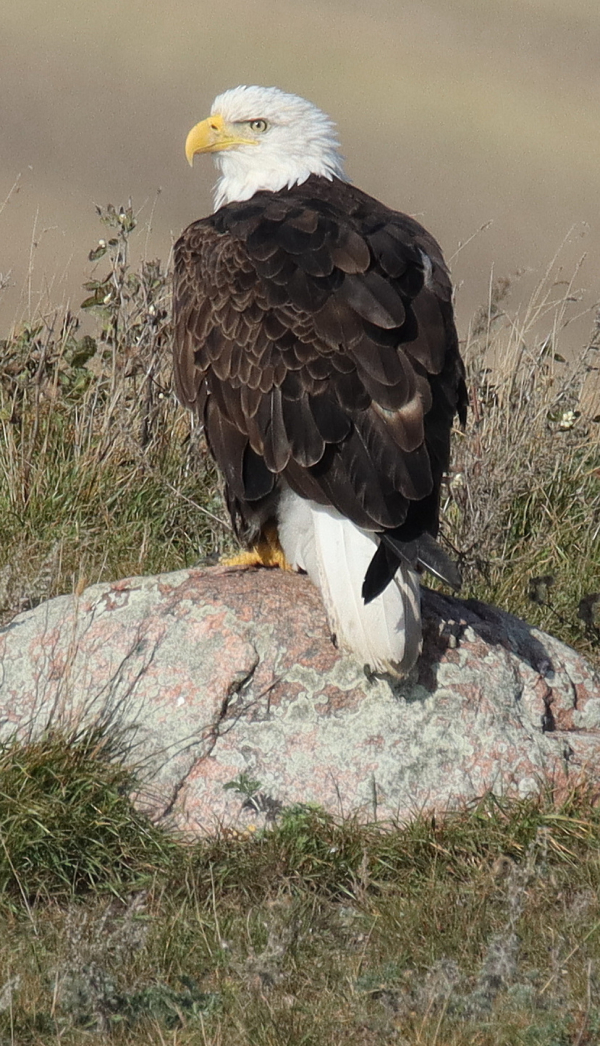
A surprise sighting of a prairie eagle, a Bald Eagle standing on a prominent granite boulder on a hilltop overlooking a deep blue marsh topped off this week’s transition to late fall in the northern plains.
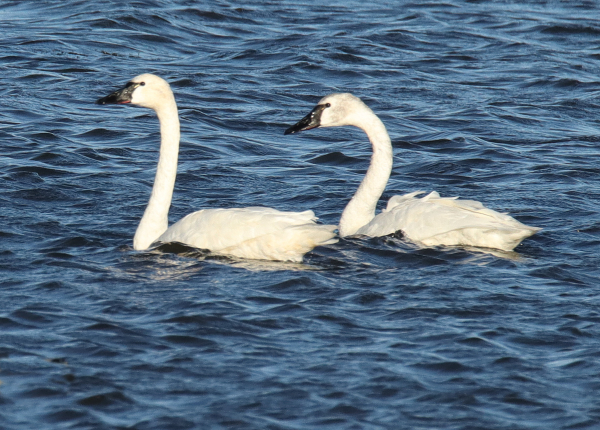
The first groups of Tundra Swans were a treat last week, varying from scattered pairs to flocks of 21 and 42. After reaching the Dakotas, rather than continuing southward, Tundra Swans migrate east during fall, wintering among the mid-Atlantic states from Maryland to North Carolina.
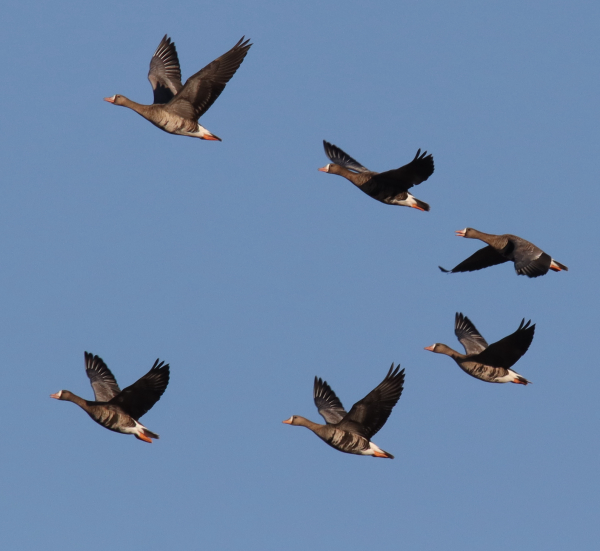
Seeing and hearing the unique calls of hundreds of White-fronted Geese at a local migration stop was a thrill that led to a few photographs. The early geese and swans were on the move south, only staying at area lakes overnight, if at all.
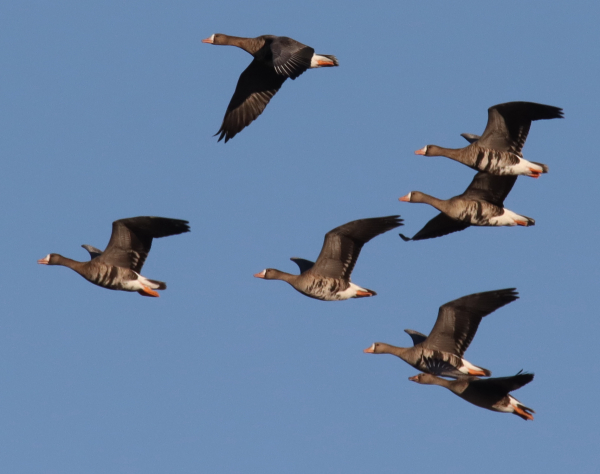
With a change in the weather forthcoming next week, tens of thousands of geese will arrive, hopefully staying to rest and feed locally as long as possible.
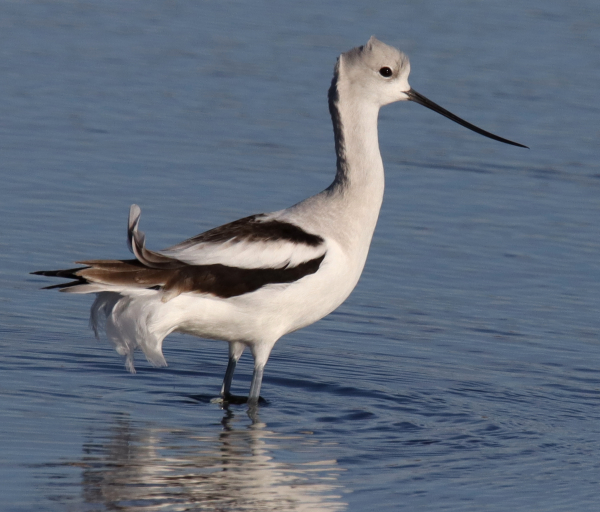
A single American Avocet graced Charo Marsh last Saturday, providing an incentive to photograph it while its plumage was reacting to a strong wind at its back, even though the shoreline water is fairly calm.
|
A few minutes after midnight Thursday morning I stepped outside and the sound of Snow Geese made me look into the starry sky. The geese were flying low and directly overhead, but although I couldn’t see the flock, I watched and listened as the next flock passed a bit farther west. There was almost a 2 week break between Snow Goose flocks in the area, and the time was right for a strong push south. The following sunny, warm afternoon was perfect for a long drive – back to the Missouri River breaks and Long Lake Refuge. I wondered what other birds filtered in overnight.
As I drove west my raptor count was definitely up from the previous week, with 39 birds of prey that included 31 Red-tailed Hawks, 3 Northern Harriers, 1 American Kestrel, 3 Bald Eagles including an adult pair and a 4th-year immy. But the prize for the day was a big female Ferruginous Hawk I sighted as I made the turn off the river road toward the Badlands outcropping area 2 miles ahead. I’ve never seen a Ferruginous Hawk along the Missouri River corridor during migration and hadn’t seen one anywhere since the end of the nesting season in late July. I considered trying to walk closer to the Ferrug but opted to wait until I checked the Badlands area out for falcons and other raptors.
There was a flock of about 20 Western Meadowlarks but no birds of prey; 4 single Ring-necked Pheasant cocks but no kestrels. Even so, the area provided an enchanting feeling as I ambled along the winding road and stopped to stand outside and take in the views. Back near the highway I thought I spied the Ferruginous Hawk flying low toward the road, but it was a male Northern Harrier. I glassed for the Ferrug, drove north a mile or so, turned around to return, and there it was, soaring above the area where I first saw it perched. I pulled over and hoped it might hunt in my direction, but it stayed a bit too high and a bit too far east for a good soaring photo, and suddenly it was out of sight as it probably caught the stout northwest wind.
I wanted to do another route through the Badlands area, and about half way to the big butte, I sighted a small raptor in flight and through binoculars could see it was an American Kestrel as it began a brief hover then a descent into a coulee and out of sight. I waited for it to show above the landscape again, then continued without another raptor to be seen, even when I watched for the kestrel on my return. It was worth a try after my great photo session with the male American Kestrel the week before.
I did see 2 Red-tails actively migrating along the hills immediately east of the Missouri River, but only saw 1 other Red-tail perched along the river road. At the crossroads where I could turn left toward Bismarck or turn right toward Long Lake National Wildlife Refuge, I turned right. For most of my drive through the refuge, the birds were mostly similar to species I found the previous week, but with far fewer Double-crested Cormorants – just a few rather than hundreds and hundreds. I did stop to photograph a Great Blue Heron standing on a prominent rock on the edge of the lake, and I also observed a group of 2 Great Blue Herons and 4 Great Egrets alert on the shore as a dozen cormorants appeared to be pushing a school of fish in their direction.
On the hill north of the refuge there were some Sandhill Cranes feeding in the field – maybe 40 – and as I continued I saw a flock of ‘pelicans’ in flight headed my way. But they didn’t fly like pelicans and through my binoculars I could see they were Tundra Swans, 21 Tundra Swans! I photographed them at long range and followed their flight for a half-mile or so, until I realized there were 3 flocks of Sandhill Cranes behind them, so I stopped to photograph the cranes as they advanced in my direction. The wild crane calls just before sunset were stirring, along with the peeping calls of the first-fall cranes that were accompanying some pairs.
I watched the cranes join a flock of about 90 feeding in a harvested grain field, and after turning around I sighted another flock of swans numbering 7. There were more flocks of Sandhills too, and I positioned myself with the hope that a flock would fly closer, until a flock of 6 Tundra Swans provided some closer photos, but not close enough. Each of the flocks of swans flew at the same elevation in the same direction, and not being aware of a water body or feeding area to the northwest, I decided to follow the last flock as they winged into the wind. The swans were focused and although I shadowed them for about 4 miles, the lack of rural roads in their direction denied me from following farther. Oh well, it sure was nice to see swans on the scene now.
Goose Music
Friday was sunny but extremely windy, but even so, during a quick break in my work day, as I was filling my feeders and bird bath, 2 flocks of Snow Geese flew directly south, one flock very high, the other at a more normal 150 feet. In spite of the strong wind, I wanted to drive south to see if I could find some geese in the area, and drawing a blank on geese, I wanted to check to see what birds were at Charo Marsh. I was surprised to immediately see a pair of Tundra Swans at Charo, along with a considerable build-up of ducks, including a large flock of Green-winged Teal, even more Mallards, Redheads, and some Northern Pintails.
The swans were at a mid-lake position fairly close to the shore, so I decided to walk closer, using a prairie hill as cover. I managed some long-range photos of the pair as they were bending their long necks into the water, feeding in the company of a couple Mallards and a pintail. But when the swans took notice, I backed away so as not to displace them or the ducks. It was a nice prairie walk though. That’s when I figured that I should check on other swan lakes in the area, and on my way to the best swan marsh, I sighted 2 more Tundra Swans on the edge of my friend Herb’s big lake. Swan marsh didn’t have any big white birds, so I decided to try one more spot – Meier’s Lake, near my great-grandparent’s farm, where my grandmother and her sisters grew up.
Meier’s Lake is best known for the large flocks of geese that assemble there during fall and spring, but Tundra Swans also stop over during fall. As I drove toward the setting sun, I could see silhouettes of a few large flocks of geese leaving the lake, which was a good signal of birds on hand. While Snow Geese are the usual stopover waterfowl there, Friday evening White-fronted Geese were in charge, with many hundreds on hand, flying south of the lake to land and feed in greening winter wheat fields. There were a couple small flocks of Snow Geese among them too, but the unique calls of White-fronted Geese drowned out other goose music in the area.
A bay on the southwest side of the lake is the usual waterfowl favorite and there were hundreds more White-fronts and Snow Geese on the water, along with many Tundra Swans! I could count 42 swans, but there must have been more behind a little hill that blocked my view into the north shore of that bay. Well, those sightings made it official, the first good push of the geese of fall have arrived, and the fun is just beginning – now until total freeze-up, which can be 2 weeks away, or 2 months away; it’s an exciting time in the neighborhood.
Continuing Trickle
At home, the Pine Siskins only persisted at my feeders through Thursday, and while the female and male Hairy Woodpeckers appear to be settling in with daily visits along with the White-breasted Nuthatches. Friday the big surprise was a female Downy Woodpecker – the first suet fan of the season. The Downy remained dedicated to my suet feeder throughout the rest of the week, but the only other yard sighting was a relatively late Northern Flicker foraging for ants in my front yard.
Saturday Search
Inspired by the swans and geese located at the end of Friday evening, after some office time I started an early search to the north, then the south, and finally to the west to see what I could find. No swans or geese were present to the north or south, not even at Meier’s Lake where there may have been a thousand birds 24 hours earlier. I headed a few miles west to check on Church Lake, where I was greeted by a small flock of White-fronted Geese feeding in a stubble field and maybe 150 Snow Geese mixed with White-fronts on a tiny island on the southwest side of the lake.
When a few White-fronts flew in to join the field-feeding flock, I thought if I positioned myself in the right location, I might get some photo action if other geese flew in. Sure enough, even before I turned off the car engine a flock of about 30 White-fronts appeared from behind a hill, headed in my direction, then turning to get the full effect of the sunlight with blue sky in the background – nice. The geese circled once before landing, and while I waited a while longer, enjoying the calls of the Arctic White-fronts, I left for lack of more action.
There were 7 Northern Harriers along my drive, but only 2 Red-tailed Hawks; an interesting switch. And as I checked one more lake that I thought my be promising, I was glad to see more Tundra Swans, 15 in all. That might be a promising location to check first thing Sunday, but it seemed the waterfowl were clearly on the move and not stopping for any length of time. After returning to my office, I texted a birding friend who works at Sand Lake Refuge, about 70 miles to the east-southeast. He noted there were some Snow Geese and Tundra Swans in the Sand Lake area, but not a lot; adding that flocks of White-fronted Geese were streaming through Saturday, headed south by the thousands.
Sunday and Monday I checked the same swan and goose lakes, but only Meier’s Lake had 10 Tundra Swans on Sunday, and a new lake closer to home had 8 distant swans. Monday, I couldn’t find any swans, but I did see an adult Bald Eagle standing on the top of the highest hill in the area where it could overlook 2 prominent lakes. I see an eagle there occasionally, but my eagle thrill came a half-hour later when I was surprised to see an adult Bald Eagle standing on a granite boulder on the top of a low hill overlooking a marsh – within photo range. Would it allow me to stop and focus my camera? Yes, indeed. The resulting portraits made me think of the term “prairie eagle,” and that’s how I entitled the image.
By the time you read this, there will be an abrupt change in the weather as a series of low fronts move across the northern plains, bringing freezing temperatures during overnight hours and warming only to the mid-30s – Yikes! That means area marshes will begin freezing by the next time I write you, but the change in weather should bring tens of thousands of 5 species of geese into the area, along with more ducks and hopefully more swans and cranes.
I’m still waiting for the native sparrows to arrive too – the Harris’s, White-crowned, White-throated, and American Tree Sparrows, along with more Dark-eyed Juncos, and some Arctic songbirds: Lapland Longspurs and Snow Buntings! When will the first Rough-legged Hawks arrive, and how about a black-morph Harlan’s Red-tailed Hawk, along with more Bald Eagles and maybe a rare in these parts Golden Eagle? I’m not ready for the cold, but I’m more than ready for the birds that will appear with the cold front. Enjoy the last week of October!
Article and photos by Paul Konrad
Share your bird sightings and photographs at editorstbw2@gmail.com